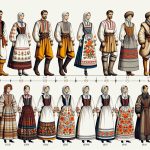
Poland is a country with a deep cultural heritage and many traditions that bring its people together. From the quiet reflection of All Saints’ Day to the festive atmosphere of Christmas and Easter, each holiday has its own special meaning and importance. These customs are a way for Poles to keep their cultural identity alive and strengthen the sense of community.
In this discussion, we’ll look at how these traditions have changed over time and what they tell us about life in Poland.
By talking about Polish customs in a simple and clear way, we aim to make it easier for everyone to understand and relate to. This approach helps avoid confusion and makes the conversation more engaging. Let’s dive into the rich world of Polish traditions and see what makes them so special.
Celebrating Christmas in Poland
In Poland, Christmas is a special time that mixes religious traditions with cultural practices, reflecting the country’s rich history and the importance of family. The celebration starts with Advent, leading up to Christmas Eve, or Wigilia, which is a highlight. On this day, families share a special wafer called opłatek and enjoy a meatless meal together, symbolizing togetherness and prosperity. Unlike some places where Christmas can be very commercial, in Poland, the focus is more on spending quality time with family and the spiritual meaning of the holiday. This approach to Christmas showcases how Polish people value their cultural identity, keeping traditions alive while adapting them over time. This blend of customs not only makes the Polish Christmas unique but also shows the influence of Slavic and Catholic traditions.
Let’s dive deeper into what makes the Polish Christmas Eve, or Wigilia, so special. The meatless feast often includes dishes like barszcz (beetroot soup) with uszka (small dumplings), various kinds of fish, pierogi (dumplings), and a compote of dried fruits for a drink. These dishes are more than just food; they represent centuries of tradition and are a way for families to connect with their heritage. After dinner, many families attend Midnight Mass, which is a beautiful service that celebrates the birth of Christ. This combination of family meals, sharing the opłatek, and attending Mass underscores the importance of faith and family in Polish Christmas traditions.
In comparing Polish Christmas traditions with those of other European countries, it’s clear that the intimate family gatherings and the emphasis on spiritual values over commercial aspects stand out. For example, while in some countries gift-giving and elaborate decorations take center stage, in Poland, the simple acts of sharing a meal and attending church services together hold more significance. This doesn’t mean that Poles don’t exchange gifts or decorate their homes; they do, but these activities complement rather than dominate the holiday.
For those interested in experiencing a piece of Polish Christmas, trying out traditional recipes or attending a Polish Midnight Mass can be a great way to start. There are many cookbooks and online resources that offer recipes for traditional Polish Christmas dishes. Additionally, Polish communities around the world often organize Christmas events that are open to everyone, providing a wonderful opportunity to learn more about these rich traditions.
Easter Traditions
Easter in Poland is a blend of religious practices and cultural traditions, deeply embedded in the country’s history. It kicks off with Palm Sunday, which commemorates Jesus’ arrival in Jerusalem. On this day, people carry beautifully woven palm branches, a symbol of joy and triumph. The following days, known as Holy Week, lead up to Easter Sunday, a day filled with celebration.
A unique Polish custom is Święconka, observed on Holy Saturday. During this tradition, people prepare baskets filled with food that holds special meanings, like bread and eggs, and take them to church to be blessed. This ritual is not just about the blessing; it’s a vivid display of Polish heritage and the importance of community and family bonds.
Easter Monday in Poland takes a lighter, more playful turn with Śmigus-Dyngus. This day involves people playfully splashing water on each other. The tradition has roots in both pagan and Christian elements, symbolizing purification and the start of spring. It’s a day filled with laughter, signifying the end of Lent and the celebration of new beginnings.
These traditions are more than just religious ceremonies. They are a way for people to connect with their heritage, reinforce community bonds, and celebrate together. For those interested in experiencing these traditions firsthand or incorporating them into their own Easter celebrations, consider crafting your own palm branch decoration or preparing a Święconka basket. These activities not only add to the festive atmosphere but also provide a meaningful way to engage with the rich tapestry of Polish culture.
Easter in Poland showcases how traditions can bring people together, offering a mix of solemn reflection and joyful celebration. Through these customs, the spirit of Easter is vividly brought to life, highlighting the importance of faith, renewal, and community in Polish society.
All Saints’ Day Observance
In Poland, Easter is a time for celebrating community and the start of spring, but All Saints’ Day, observed every November 1st, is a time to remember and honor those who have passed away. This day is deeply important in Polish culture and spirituality, as it goes beyond just remembering the dead. Polish families come together at cemeteries, decorating graves with candles and flowers. This creates a peaceful atmosphere that highlights the strong connection between the living and the deceased.
What makes All Saints’ Day special in Poland is the intensity of the observance. Unlike in some other countries where remembering the dead might be more personal, in Poland, it’s a community activity. This shows a strong sense of collective mourning and memory. The day is not just about remembering individuals but also about reinforcing family and national bonds.
For example, the sight of cemeteries lit up by thousands of candles on All Saints’ Day is unique to Poland. It represents the collective spirit of the Polish people and their approach to commemorating loved ones. This tradition underscores the importance of community and shared memories in Polish culture.
In talking about All Saints’ Day, it’s crucial to understand its role in Polish society. It’s a day that brings people together in shared remembrance, showing how traditions can help maintain bonds among the living and with those who have passed away. This observance is a powerful expression of Poland’s cultural identity, highlighting values like family unity and collective memory.
Weddings and Family Customs
Polish weddings and family customs play a crucial role in celebrating cultural heritage and reinforcing social connections. These traditions, with deep historical roots, offer a window into how societal practices evolve over time. Take the ‘Oczepiny’ ceremony, for example, where the bride marks her transition to womanhood. This ritual is more than just a personal milestone; it reflects the community’s views on marriage and gender roles. By looking at this and other customs, we see how tradition and modern influences intertwine.
In Poland, the importance of family and community is evident in the way extended families come together after the wedding. Unlike the more individual-focused customs seen in some cultures, Poles place a high value on kinship. This emphasis on family gatherings not only strengthens bonds but also showcases the Polish priority on collective over individual well-being.
Let’s get a bit more specific. During the wedding, there’s a moment when guests and family participate in games and activities that symbolize the couple’s new journey together. This could include anything from a playful mock kidnapping of the bride, known as ‘Przebieranki,’ to the shared bread and salt ritual, symbolizing prosperity and health. These moments are not just for fun; they’re a nod to the importance of community support in Polish culture.
Moreover, the blend of old and new in Polish weddings is fascinating. While many couples still adhere to traditional customs, there’s a growing trend of incorporating modern elements, like destination weddings or personalized vows. This mix shows how traditions evolve, reflecting current societal values while still honoring the past.
In a nutshell, Polish weddings and family customs are a vibrant part of the country’s cultural landscape. They highlight the balance between tradition and modernity, the importance of community, and the evolving nature of societal values. Whether you’re attending a Polish wedding or just curious about different cultures, these traditions offer a rich insight into the values that shape Polish society.
Seasonal Festivals and Fairs
In Poland, seasonal festivals and fairs are much more than just events; they are a way for people to connect with their cultural roots and celebrate the changing seasons. From the spring planting to the winter solstice, each season has its own unique set of celebrations. These festivals are not just about having fun; they’re a bridge between the past and the present, blending ancient pagan traditions with Christian holidays to create something truly special.
For example, in spring, you might experience the ‘Marzanna’ parade, where communities build and then drown a straw effigy to symbolize the end of winter and the rebirth of spring. This is a vivid example of how these festivals use symbolic actions to mark the passage of the seasons. In summer, one of the biggest events is the Midsummer Night, also known as St. John’s Night, where people light bonfires, float wreaths on water, and search for the mythical fern flower, celebrating the longest day of the year with traditions that date back to pre-Christian times.
Autumn brings the harvest festivals, a time to give thanks for the bounty of the land. Villages and towns across Poland host fairs where you can taste traditional foods like pierogi and bigos, and watch or participate in folk dancing and music. It’s a direct way to experience Polish culture and see how these traditions are kept alive by the community.
Finally, the winter solstice celebrations are a mix of solemnity and joy, with customs such as sharing ‘opłatek,’ a Christmas wafer, and singing carols. These traditions are deeply embedded in the Polish way of life, offering warmth and light during the darkest time of the year.
Besides being fun, these festivals and fairs play a crucial role in preserving Polish folk art, music, dance, and culinary traditions. They’re not just for locals; visitors are welcomed to join in and experience the rich tapestry of Polish culture. Whether it’s through enjoying a hearty meal, dancing to lively tunes, or simply observing these age-old customs, these events offer a unique way to understand and appreciate the enduring spirit and identity of Poland.
Conclusion
Polish holidays, customs, and traditions are a big part of what makes the culture so unique and vibrant. Think about the cozy family gatherings during Christmas and Easter, or how everyone comes together on All Saints’ Day. These traditions aren’t just for fun; they help keep the community close and pass on important cultural values from one generation to the next.
Plus, let’s not forget about the seasonal festivals and weddings – they’re perfect examples of how Poles love to celebrate together and hold onto their cultural identity. When you take a closer look, it’s clear that these traditions are key to keeping the Polish way of life alive and well.






Comments are closed.